Successful Ageing: Progressive Governance and Collaborative Communities
ETHOS Issue 19, Jul 2018

Ageing is a key demographic challenge facing many Asian countries. Lower fertility rates and increased longevity mean that the number of seniors is expected to double to over 900,000—or 1 in 4 Singaporeans—by the year 2030.
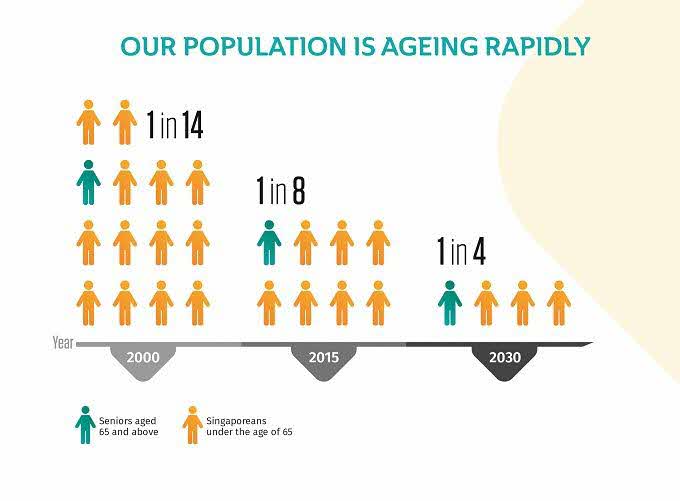
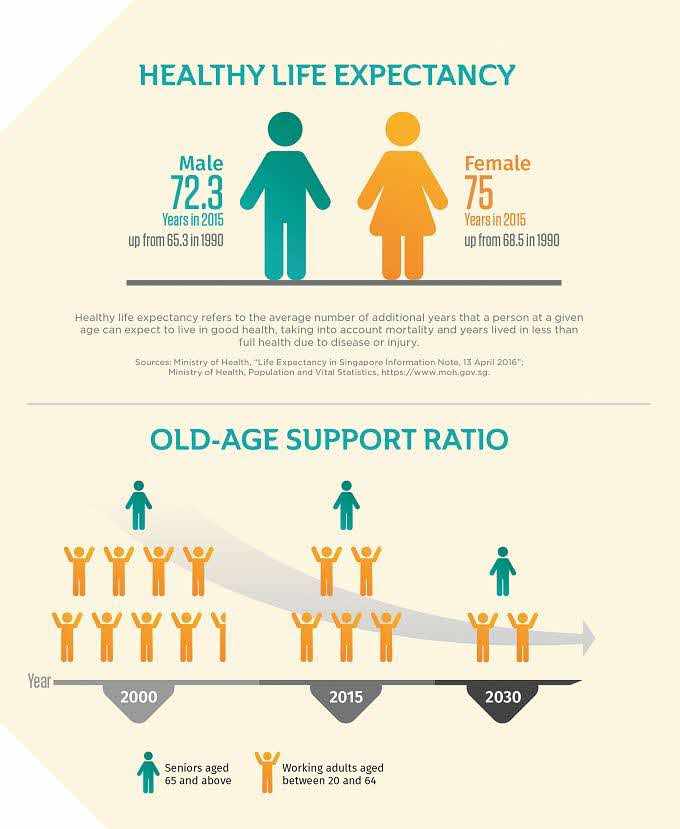
Singapore has taken a whole-of-nation approach to preparing for population ageing. A Ministerial Committee on Ageing was established to coordinate government policies and programmes relating to population ageing. In 2015, the Committee launched an Action Plan for Successful Ageing which forms the nation’s blueprint for preparing Singaporeans to age well.
Looking and Planning Ahead, Whole-of-Nation
Singapore’s vision of a Senior Friendly City works at three levels: national, community and individual. At the national level, Singapore aims to be a City for All Ages. At the community level, Singapore wants to be a Kampong for All Ages. At the individual level, Singapore promises Opportunities for All Ages (see the Ministry of Health’s “Factsheet on Action Plan for Successful Ageing”).
Singapore aspires to be a home which enables its seniors to continue to grow and develop as individuals, even in their later years.
With advancements in human development and technology—from good public health to modern modes of transport and better digital services—our later years need not be a steep decline after an arbitrary age threshold. Teoh Zsin Woon, Deputy Secretary (Development) at the Ministry of Health, believes that the new narrative for ageing in Singapore is one of “productive longevity”. Instead of a “hump”, Teoh suggests that we can have different experiences and continue to learn, grow, develop and flourish throughout our lives.
However, to be able to achieve productive longevity may require us to organise our workplaces, social systems and even urban environments, differently.
“Many of us may have been socialised into thinking that life is a ‘hump’: you begin life as infant, growing into your teens and early adulthood before maturing at your peak. Thereafter, it is downhill all the way …”
—Teoh Zsin Woon
Seniors as Individuals
At the individual level, Teoh believes that it is important to create more opportunities for seniors to stay active and engaged.
Hence, under the Action Plan for Successful Ageing, the National Silver Academy was established to enable seniors to learn, for learning’s sake. It offers a range of courses by post-secondary education institutions to seniors who feel that they would still like to learn to keep their minds active and to keep in touch with family, families and world affairs.
These are all supported by both communities and the government, and aimed at fueling a new narrative about ageing. Instead of associating seniors with recipients of help, the Silver Volunteer Fund empowers seniors to contribute to society as volunteers.
“We want to create a society where our seniors are visible. No matter your age, everyone is a valued member of our community.”
—Teoh Zsin Woon
Seniors as Members of Society
Teoh believes that people’s responses to ageing will change over time. The goal is a society in which seniors are visible, and where everyone is a valued member of the community regardless of age.
An example of this principle in action is Kampong Admiralty, a new public housing intiative designed and built for residents of all ages. Here, facilities for seniors are integrated within the community and co-located with facilities for children.
Another initiative is the revamp of St Joseph’s Home which used to only offer nursing and hospice services to seniors. Since August 2017, however, an infant and childcare centre has begun to operate out of the same location. The childcare centre’s curriculum includes interaction with seniors so that the children get accustomed to issues of ageing and are at ease in the company of seniors. Seniors and children share an inter-generational playground that allows even those with disabilities to play with the children. Such interactions are important to nurture, because as family sizes become smaller, there are fewer opportunities for children to be in touch with their grandparents.
Teoh is also a firm advocate for ageing in place. She strongly believes that it is important to preserve a person’s sense of autonomy and independence, even as he or she gets older, so that he or she can age with dignity.
Therefore, close collaboration among different infrastructure agencies is needed to make our city an enabling one—one which allows the seniors, even those with physical or cognitive frailty, to age in place, and which gives them a sense of security and the confidence to continue to go out and lead active lives. Under the Action Plan for Successful Ageing, government agencies—from the Housing Development Board (HDB) to the Land Transport Authority, National Parks Board to the Urban Redevelopment Authority (URA)—work in concert to implement a comprehensive suite of plans to make Singapore a City for All Ages. These plans include new housing options for seniors, senior friendly transportation as well as therapeutic parks for seniors.
In 2015, the Ministerial Committee on Ageing announced a $3-Billion Action Plan for Successful Ageing covering over 70 initiatives in 12 areas to help Singaporeans age confidently and lead active lives, with strong bonds with family and community.
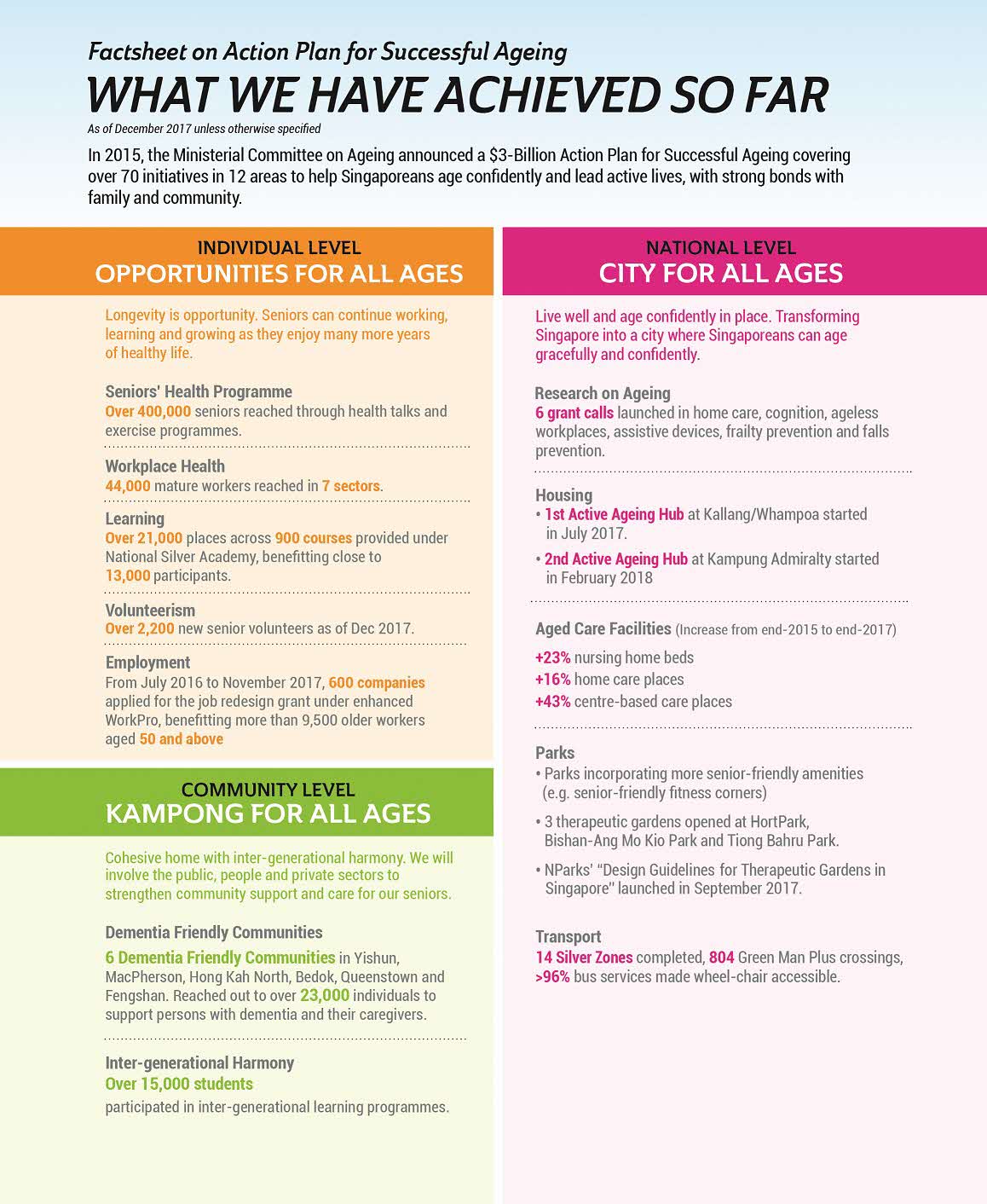
Source: Ministry of Health
Involve Community as Stakeholders
The Action Plan for Successful Ageing was put together after extensive consultation with seniors and stakeholders from diverse backgrounds. For example, together with HDB and URA, the Ministry of Health (MOH) conducted focus groups on housing options, urban design and barrier free access. These inputs from the seniors and other members of the community enrich the agencies’ understanding of what really matters to seniors in terms of their living environment.
Our high density living environment can also be an advantage in forming strong communities of care—if we engage residents and link up community assets to form “vertical kampongs”. The Residents’ Committees Centres within public housing estates make for convenient “active aging hubs” for seniors to participate in community health programmes, such as the Health Promotion Board’s well-attended weekly exercise sessions. In several residential precincts, seniors in their 60s and 70s are volunteering to befriend and care for other older seniors living within the same neighbourhood. As we build up these “communities of care”, we also enhance the social capital within communities.
Silver Generation Ambassadors
The Silver Generation Ambassadors (SGAs)1 conduct door to door outreach to all Singaporeans aged 65 years and above. These SGAs explain to seniors the government schemes that can help them, and serve to link seniors’ needs with available government help schemes. Beyond this, SGAs are also trained as the frontline of our community care system—to pick up emerging health or social issues faced by seniors and get them help early, as well as to persuade seniors to participate in exercises and preventive health checks in their immediate neighbourhood. They form the bedrock of a uniquely Singapore response to population ageing.
Notes
- There are about 3,000 SGA volunteers who have undergone training on government programmes for seniors, with some basic knowledge on how to recommend and encourage seniors to stay active.
Community Partnerships
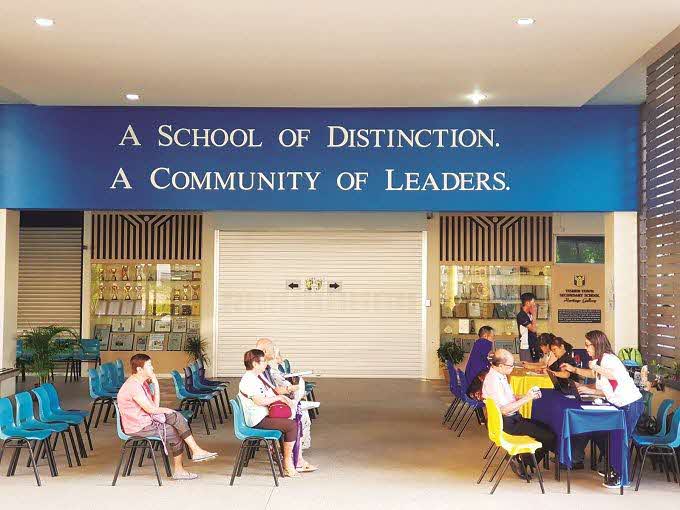
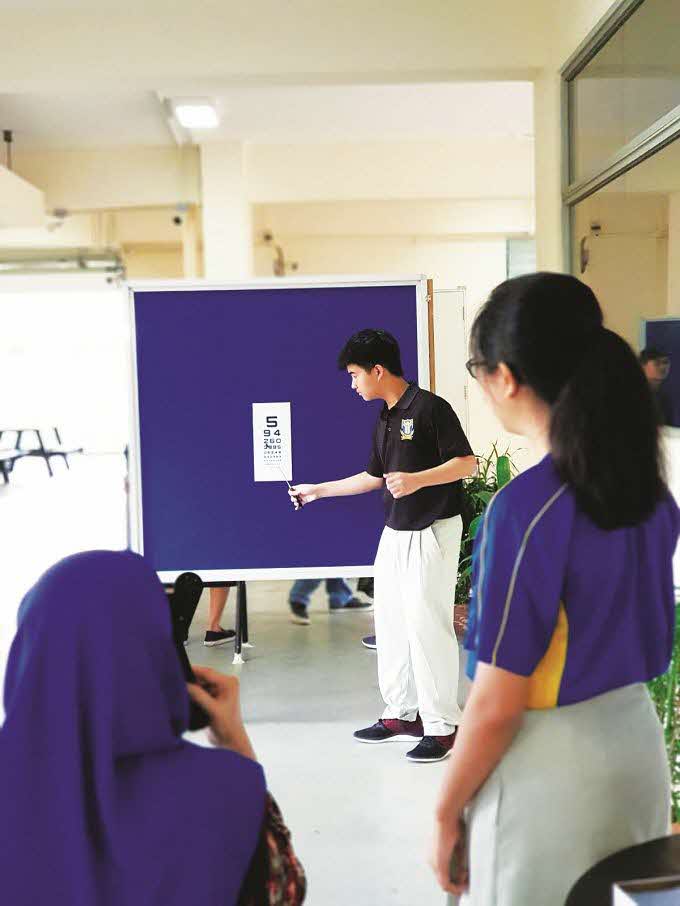
Functional screening at Yishun Town Secondary School where students volunteer to conduct basic eye checks for seniors
Source: Agency for Integrated Care
Teoh, who leads the MOH’s Ageing Planning Office (APO), envisions a “school health service” equivalent for our seniors in the community. Just like school children who get their regular health checks, PE lessons, vaccinations and dental checks systematically in schools, the same must happen in the community for seniors, now that our age curve has shifted decisively.
To achieve this vision, MOH works with grassroots organisations, senior activity centres and even schools, leveraging existing spaces to bring health checks to seniors. On weekends, school children volunteer to help conduct eye checks for seniors as their school premises turn into health centres for seniors to undergo functional screening, and their school dental buses double up to provide follow-up dental treatment for seniors with oral health issues.
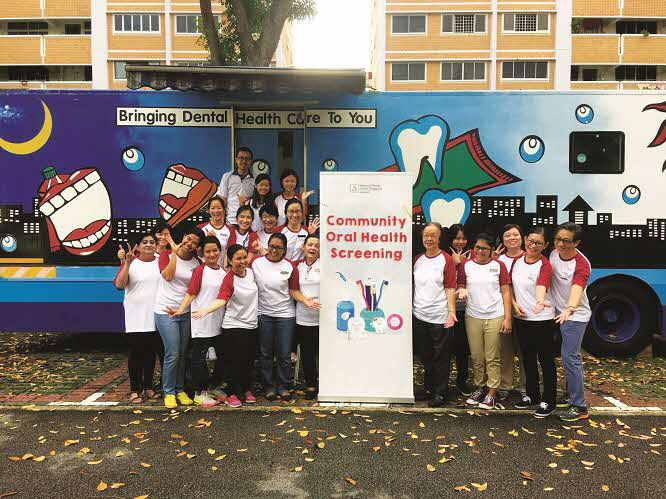
The team from the National Dental Centre Singapore providing dental follow-up treatment for seniors at Dunman Secondary School
Source: Agency for Integrated Care
Ultimately, because of the magnitude of population ageing, everyone has to play a part to achieve successful ageing for our population. Close collaboration between sectoral partners is a must, even though trying to bring together different systems and processes, and capability levels, can be challenging. For Teoh, it is about focusing on a shared purpose and common desired outcomes.
Joint planning and programming between communities and government, using data and leveraging existing infrastructure, gives new life and new social purpose to some of these spaces. This mode of programme delivery allows for much faster implementation across the island than just depending on building new infrastructure or retirement villages.
“Population ageing is huge. I need all the productive energies in each community. I need the community to embrace and to care for the seniors. We really need to combine our resources and everybody needs to chip in to take care of our seniors in each community.”
—Teoh Zsin Woon
Tapping on Technology
Reaching out to seniors, meeting their needs and coordinating programmes and service offerings from providers across all sectors is a massive undertaking. However, the use of appropriate technology can greatly increase the reach and maximise the impact of this effort. MOH makes use of the URA’s ePlanner, a one-stop, multi-platform geospatial urban planning analytics tool. The ePlanner lets MOH visualise local data on the senior population, so as to better plan and stage new programmes and site new facilities and services for seniors. By better identifying “hotspots” of needs, MOH can be targeted in working with both the healthcare providers as well as local community-based organisations to plan new health and social programmes to meet local needs.
The Power of Data Analytics: ePlanner & GEMMA
Developed in-house, URA’s ePlanner and GEMMA (GIS enabled mapping, modelling and analytics) are digital geospatial urban planning tools.
ePlanner allows city planners to easily visualise, analyse, overlay and interpret data from multiple sources to understand the housing and demography profiles and location of facilities in each area. This provides a more data-informed way for planners to assess residents’ needs and to plan for amenities to be sufficient and also more accessibile.
For example, by incorporating social data into the ePlanner, MOH is able to identify areas with a higher concentration of seniors living alone, and prioritise the development of befriender programmes to start in these areas.
GEMMA will take infrastructure planning for seniors to the next level. Planners across agencies use advance spatial analytics within to jointly analyse and map medium-to-long term planning scenarios, and to support planning and decision making. For example, they can identify and propose possible sites for a future aged care facility, as well as work with social agencies to identify opportunities to co-locate with complementary services to create synergies.
“Through conscious urban design and facility placement, we want to rekindle that magical bond between the young and old. We want our younger people to feel the love from the older people; and for the older people to fill their days with the laughter from the young.”
—Teoh Zsin Woon
Looking into the Future
Singapore has not seen the peak of its ageing phenomenon yet: a new wave of seniors who will soon reach the age of 65 is on the horizon. The measures being put in place today are not early but they are necessary and urgent. And there is more work to be done. As the population ages further, needs will also evolve. This is why Teoh thinks it is vital to build up the social infrastructure in tandem with the physical infrastructure.
At the same time, Teoh believes there is no one best path in achieving this, and that many options will open up as society matures and fresh ideas emerge. But the APO team is seeking the most optimistic path in bringing the promise of successful ageing to Singapore’s seniors. In the longer term, this may have benefits and implications not just for Singapore but also the rest of Asia whose populations are also ageing rapidly.

